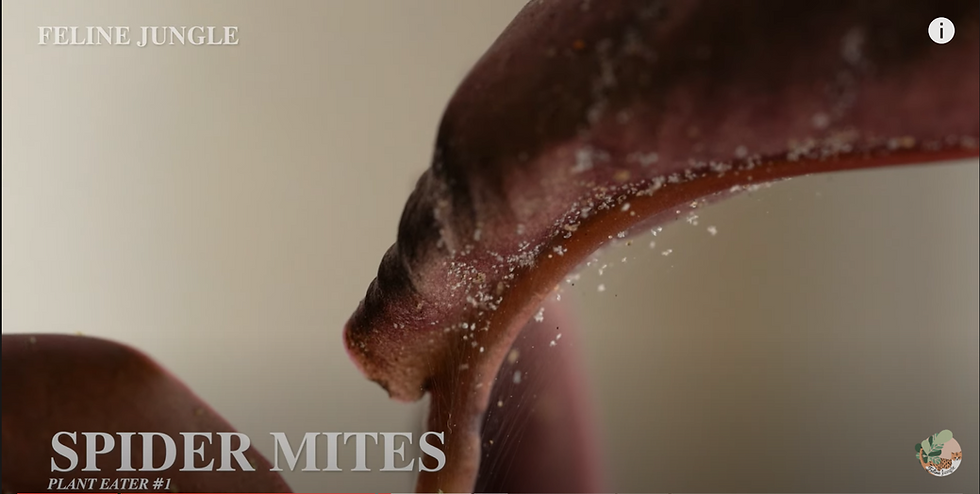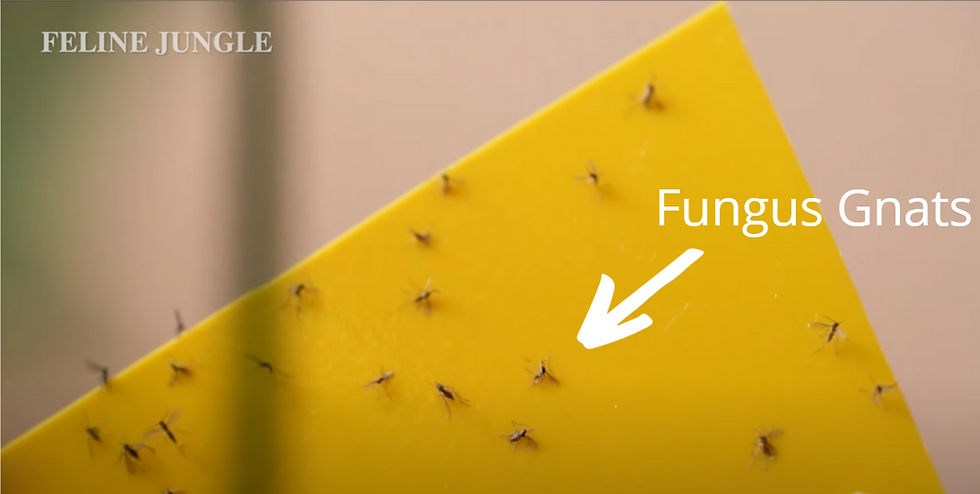Houseplant Pests Control & How to Identify Them
- Feline Jungle

- Sep 19, 2021
- 5 min read
Updated: Feb 5, 2022
Finding bugs on your plants is always a scary moment, but unfortunately, it is inevitable. While some bugs are just annoying, some are annoy and harmful to your plants. These are called pests. Read on to find out about some quick tips and tricks on how you can control them.
Disclosure: This article contains affiliate links. When you click these links and make a purchase, I may get a small commission. It won’t cost you anything, but it helps me to run this site. Thank you for supporting my plant and cat journey! Let’s grow together 🐱💚🌱
How to Identify Harmful Bugs?
One of the detrimental effects of bugs is patchy areas of bug bite marks on leaves causing the yellowing of newer or random leaves. In that case, check the back of your leaves for bugs. Some of the most common pests are fungus gnats, spider mites, mealy bugs, or scales on the back of the leaf.
Fungus Gnats
Fungus gnats are the least harmful type of pest. They are usually grayish or black in color and look like tiny mosquitoes. These bugs love humidity and feed off of rotting roots. Compared to some of the other pests stated, these are not as harmful but are definitely concerning if they are present in large numbers. This is why you must let your soil dry before watering it again. Here are some simple products to get rid of them:
These are the most effective ones, and the bugs seem to love the bright yellow color of the tape. The traps come in many shapes and sizes, and you can get creative putting them up. I like to get these Yellow Fly Traps, 20 large sheets for $9.99 that come in big sheets. I like to cut them into smaller pieces to put them in a particular infested pot so that I can catch them before they start flying around!! With this method, I find that the product last longer. More bang for your buck.
This product consists of corn cob granules that are coated in BTI. BTI or Bacillus thuringiensis israelensis is a biological larvicide. It is a naturally occurring bacterium that is deadly to fungus gnat larvae as well as mosquito larvae. I like using mosquito bits because you go straight to the source and kill the babies before they start flying around. The most effective method is to make a "mosquito bit tea". I soak 2 spoonful of it into 1 gallon of water for 15 minutes before watering my plants. Click here to learn more about the mosquito bits I use for my plant.
***Need more ways to get rid of fungas gnats? Here is the link to my video for 12 EASY Solutions for Fungus Gnats.
Spider Mites
They look like white and yellow spiders and usually spin a web on the leaves of plants. You can see the webbing under natural lighting. Spider mites not only eat your plants but also lead to the weakening of the plant's defensive system. I first found them on my Alocasia Elephant Ear plant. (Apparently, Alocasias are spider mite magnets). They seem to prefer plants with thinner leaves.

Mealy Bugs
They are bigger than spider mites, white in color, and fuzzy. These bugs suck the sap out of your plant. Moreover, they are usually found in corners and places that are harder to reach. I notice that these bugs like to be on thick succulent leaves like this aloe plant below.

Scales
Unlike other types of bugs, scales stay in one place and grow in a cluster. In a way, this makes them easier to clean. For instance, they look like round shells and pierce the plant. Since they don't really move, I didn't even know them on my Opuntia plant in the beginning. Slowly, I began to notice more and more of these clusters and that's when I realized they were scales... Check on your plants regularly!

How to Treat Bugs?
Here are some handy tips on how you can treat your plants from bug infestations:
If you find any strange activities on a plant, make sure to isolate it and check the surrounding plants as well. Check your new plants, too, for any signs. If you do, isolate them for a week before putting them with your other plants.
Always remove the pests from your plants. The easiest way to do this is to wash the plants under running water. However, if the bugs are in more difficult places, I usually use soapy water and a Q-tip.
If there are any remaining bugs after this, you can use a pesticide to kill them off. The pesticide I use is Captain Jack's Dead Bug Brew, which is also non-toxic to pets. I also use neem oil, but it tends to smell terrible and can burn your plant if you do not keep it under the shade. When using a new product, always test it on a portion of leaves to see the reaction. Calatheas and anthuriums seem to be the most sensitive, in my experience.
Preventative Measures: My Pest Control Routine
The key to pest control is preventative measures. Here is my pest control routine:
Once a month, I deep cleanse my plants with a pesticide spray. Then, I take them to the bathroom and spray everything, from the top of the leaf to the undersides and the soil. This ensures that you kill any bugs or eggs that are hiding away. This is more useful in summers when there are more bugs.
Other Tips for Pest Control:
Use Chemical Fertilizers
Organic and DIY fertilizers like banana peels, peanuts, coffee grounds, etc., tend to attract bugs due to their smell. Chemical fertilizers that come in a liquid form work better. If you do use organic fertilizers, make sure to cover up the soil to prevent bugs from coming.
Consider Hydroponics and Semi-Hydroponics
Semi-hydroponics use inorganic materials like LECA and lava stone which is hard for bugs to lay eggs on. This prevents infestation. To learn more about Semi-hydroponics/ hyrdroponic, check out this link to my video.
Use Cinnamon in Soil
You can put cinnamon in your soil. It acts as a fungicide and destroys the fungus that the fungus gnat's larvae feed on.
Plant Carnivorous Plants
These types of plants eat bugs and pests. Subsequently, your plants are protected from them.
Conclusion
There are always going to be bugs around your plants. However, it is crucial to treat these unwanted pests. Some affordable solutions are sticky tapes and mosquito bits. For more harmful bugs, you have to isolate and treat them. Also, remember to set up a preventative routine to limit pest outbreaks. For a list of all the essential products I use to prevents pest click here.















































If you're searching for trusted pest control companies Kitchener, this service offers fast, professional solutions for all types of pest problems. Highly recommended!
Compare top pest control companies Vancouver for quality services.